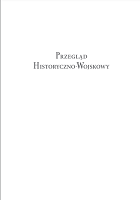Problemy organizacyjne kobiecego ruchu kombatanckiego w II Rzeczypospolitej
Organizational Problems of the Female Veteran’s Movement in the Second Polish Republic
Author(s): Marta SikorskaSubject(s): Gender Studies, Military history, Political history, Social history, Gender history, Interwar Period (1920 - 1939)
Published by: Wojskowe Biuro Historyczne im. gen. broni Kazimierza Sosnkowskiego
Keywords: combatant movement; women’s history; FIDAC Auxiliaire;
Summary/Abstract: The article discusses the activities of the female veteran’s movement in the Second Polish Republic. Organizational problems associated with the activities of the movement are analyzed, with particular emphasis being placed on internal ideological disputes that existed within the movement, which intensified after 1926. Issues surrounding Polish representation on the international stage are also analyzed. One of the most important aspects concerning the organization and functioning of the female veterans’ movement was the establishment in 1925 of the Fédération Interallié des Ancies Combatttants Auxiliaire (FIDAC Aux.). Poland was initially represented at FIDAC Aux. by organizations associated with the political movement Endecja. This situation changed in the early 1930s, after the Piłsudski camp gained control of the veteran’s movement. Between 1932–1933, the Polish female representation in FIDAC Aux. was restructured to include organizations associated with the Polish Legions that fought during World War I, with Aleksandra Piłsudska and General Roman Górecki playing a key role in these transformations.
Journal: Przegląd Historyczno-Wojskowy
- Issue Year: XXIII/2022
- Issue No: 3
- Page Range: 93-118
- Page Count: 26
- Language: Polish

